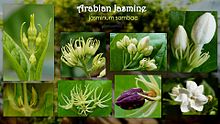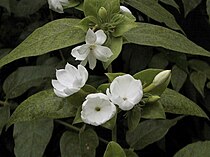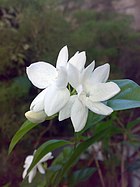Jasminum sambac
| Jasminum sambac | |
|---|---|

| |
| A 'Maid of Orleans' cultivar from Tunisia | |

| |
| various Flower stages | |
| Scientific classification | |
| Kingdom: | Plantae |
| Clade: | Tracheophytes |
| Clade: | Angiosperms |
| Clade: | Eudicots |
| Clade: | Asterids |
| Order: | Lamiales |
| Family: | Oleaceae |
| Genus: | Jasminum |
| Species: | J. sambac
|
| Binomial name | |
| Jasminum sambac | |
| Synonyms[1][2] | |
| |
Jasminum sambac (Arabian jasmine or Sambac jasmine)
Jasminum sambac is a small shrub or vine growing up to 0.5 to 3 m (1.6 to 9.8 ft) in height. It is widely cultivated for its attractive and sweetly fragrant flowers. The flowers may be used as a fragrant ingredient in
Description
Jasminum sambac is an
The leaves are
The flowers bloom all throughout the year and are produced in clusters of 3 to 12 together at the ends of branches.[12] They are strongly scented, with a white corolla 2 to 3 cm (0.79 to 1.18 in) in diameter with 5 to 9 lobes. The flowers open at night (usually around 6 to 8 in the evening), and close in the morning, a span of 12 to 20 hours.[6] The fruit is a purple to black berry 1 cm (0.39 in) in diameter.[11]

Taxonomy and nomenclature
Jasminum sambac is classified under the
The English
The Medieval Arabic term "zanbaq" denoted jasmine flower-oil from the flowers of any species of jasmine. This word entered late medieval Latin as "sambacus" and "zambacca" with the same meaning as the Arabic, and then in post-medieval Latin plant taxonomy the word was adopted as a label for the J. sambac species.[18] The J. sambac species is a good source for jasmine flower-oil in terms of the quality of the fragrance and it continues to be cultivated for this purpose for the perfume industry today. The Jasminum officinale species is also cultivated for the same purpose, and probably to a greater extent.
In 1753,
Cultivation
The sweet, heady fragrance of Jasminum sambac is its distinct feature. It is widely grown throughout the tropics from the
Typically, the flowers are harvested as buds during early morning. The flower buds are harvested on basis of color, as firmness and size are variable depending on the weather. The buds have to be white, as green ones may not emit the characteristic fragrance they are known for.[12] Open flowers are generally not harvested as a larger amount of them is needed to extract oils and they lose their fragrance sooner.[6]
J. sambac does not tolerate being frozen, so in temperate regions must be grown under glass, in an unheated greenhouse or conservatory. It has an intense fragrance which some people may find overpowering. In the UK this plant has gained the Royal Horticultural Society's Award of Garden Merit.[21][22]
Cultivars
There are numerous
- 'Maid of Orleans' – possesses flowers with a single layer of five or more oval shaped petals. It is the variety most commonly referred to as sampaguita and pikake.[6][12] It is also known as 'Mograw', 'Motiya', or 'Bela'.[23]
- 'Belle of India' – possesses flowers with a single or double layer of elongated petals.[23]
- 'Grand Duke of Tuscany' – possesses flowers with a doubled petal count. They resemble small white roses and are less fragrant than the other varieties. It is also known as 'Rose jasmine' and 'Butt Mograw'.[23] In the Philippines, it is known as kampupot.[6]
- 'Mysore Mallige' – resembles the 'Belle of India' cultivar but has slightly shorter petals with distinct and immense fragrance.[23]
- 'Arabian Nights' – possesses a double layer of petals but is smaller in size than the 'Grand Duke of Tuscany' cultivar.[23]
Chemical composition
Jasminum sambac contains
family named jasmintides were isolated from this plant.Its aroma is caused by a variety of compounds including benzyl alcohol, tetradecamethylcycloheptasiloxane, methyl benzoate, linalool, benzyl acetate, (-)-(R)-jasmine lactone, (E,E)-α-farnesene, (Z)-3-hexenyl benzoate, N-acetylmethylanthranilate, dodecamethylcyclohexasiloxane, (E)-methyl jasmonate, benzyl benzoate and isophytol.[citation needed]
Importance
Southeast Asia
Philippines
Jasminum sambac (

Its most widespread modern common name "sampaguita" is derived from the
Sampaguita garlands are used as a form of bestowing honour, veneration, or accolade.
Jasminum sambac is the subject of the
-
A sampaguita flower necklace purchased in the Philippines
Indonesia

Jasminum sambac (
It has long been considered a sacred flower in Indonesian tradition, as it symbolizes purity, sacredness, and sincerity. It also represents the beauty of modesty; a small and simple white flower that can produce such sweet fragrance. It is also the most prevalent flower in wedding ceremonies for ethnic Indonesians, especially in the island of Java.[38] Jasmine flower buds that have not fully opened are usually picked to create strings of jasmine garlands (Javanese: roncen melati). On wedding days, a traditional Javanese or Sundanese bride's hair is adorned with strings of jasmine garlands arranged as a hairnet to cover the konde (hair bun). The intricately intertwined strings of jasmine garlands are left to hang loose from the bride's head. The groom's kris is also adorned with five jasmine garlands called roncen usus-usus (intestine garlands) to refer its intestine-like form and also linked to the legend of Arya Penangsang. In Makassar and Bugis brides, the hair is also adorned with buds of jasmine that resemble pearls. Jasmine is also used as floral offerings for hyangs, spirits and deities especially among Balinese Hindu, and also often present during funerals. In South Sumatran traditional costume, the bungo melati pattern in Palembang songket fabrics depicts the jasmine to represent beauty and femininity.
The jasmine symbolizes a wide variety of things in Indonesian traditions; it is the flower of life, beauty and festive wedding, yet it is also often associated with spirits and death; the sudden scent of jasmine is often an
In Indonesia,
Cambodia
In
Thailand
In
East Asia
China
In China, the flower (
Hawaii
In Hawaii, the flower is known as pīkake, and is used to make fragrant
The Middle East
In Oman, Jasminum sambac features prominently on a child's first birthday.[citation needed] They are used to make thick garlands used as hair adornments. Flowers are sprinkled on the child's head by other children while chanting "hol hol". The fragrant flowers are also sold packed in between large leaves of the Indian almond (Terminalia catappa) and sewn together with strips of date palm leaves.[20] In Bahrain The flower is made into a pin along with the leaf of a palm tree to commemorate the martyrs of the country, similar to the White Poppy flower.[citation needed]
South Asia
Jasmine is considered to be a sacred flower in Hinduism. It is one of the most commonly grown ornamentals in India, Bangladesh and Pakistan, where it is native.[10][26] At Indian weddings, the bride often adorns her hair with garlands made of mogra, either around a bun or wrapped across a braid.
Sri Lanka
In Sri Lanka it is widely known as pichcha or gaeta pichcha. The name sithapushpa and katarolu are also used in older texts. The flowers are used in Buddhist temples and in ceremonial garlands.[citation needed]
Toxicity
The LD50 of jasmine extract is greater than 5 mg/kg by weight.[45]
See also
- List of Jasminum species
- Jasmine
- Jasminum multiflorum – the Indian jasmine
- Jasminum officinale – the common jasmine
- Cananga odorata, the ylang-ylang, another plant widely used in perfumes
References
- ^ a b "Jasminum sambac (L.) Aiton". Germplasm Resources Information Network. Agricultural Research Service, United States Department of Agriculture. Retrieved 8 March 2011.
- ISBN 978-84-8476-272-0.
- ^ "Jasminum sambac (L.) Aiton, Oleaceae". Pacific Island Ecosystems at Risk (PIER). 18 October 2006. Retrieved 8 May 2011.
- ^ "Jasminum sambac". Missouri Botanical Garden. Retrieved 25 November 2019.
- ^ Olveros-Belardo, Luz; Smith, Roger M.; Ocampo, Milagros P. (990). "Some Components of the Absolute of the Rowers of Jasminum sambac (l.) Ait" (PDF). Transactions of the National Academy of Science and Technology. 12 (6): 129–140.
- ^ a b c d e f Fernando C. Sanchez Jr.; Dante Santiago; Caroline P. Khe (2010). "Production Management Practices of Jasmine (Jasminum sambac (L.) Aiton) in the Philippines" (PDF). Journal of the International Society for Southeast Asian Agricultural Sciences. 16 (2): 126–136. Archived from the original (PDF) on 28 June 2011. Retrieved 8 May 2011.
- ^ "Plants of the World Online | Kew Science". Plants of the World Online.
- ^ "Biota of North America Program".
- ^ Pangilinan Jr., Leon (3 October 2014). "In Focus: 9 Facts You May Not Know About Philippine National Symbols". National Commission for Culture and the Arts. Archived from the original on 26 November 2016. Retrieved 8 January 2019.
- ^ )
- ^ a b c "Jasminum sambac (Linnaeus) Aiton, Hort. Kew. 1: 8. 1789". Flora of China. Retrieved 8 May 2011.
- ^ a b c d e f Kenneth W. Leonhardt; Glenn I. Teves (2002). "Pikake A Fragrant-Flowered Plant for Landscapes and Lei Production" (PDF). Ornamentals and Flowers. College of Tropical Agriculture and Human Resources (CTAHR), University of Hawai'i at Manoa. Retrieved 8 May 2011.
- ^ a b B.K. Banerji; A.K. Dwivedi. "Fragrant world of Jasmine". Floriculture Today, National Botanical Research Institute. Archived from the original on 7 December 2010. Retrieved 8 May 2011.
- ISBN 978-3-540-40593-1.
- ^ "Jasminum sambac (L.) Aiton: Arabian jasmine". PLANTS profile, Natural Resources Conservation Service, United States Department of Agriculture. Retrieved 8 May 2011.
- ^ ISBN 978-962-07-3152-5.
- ISBN 978-81-89422-35-6.
- ^ Dictionnaire étymologique des mots français d'origine orientale, by L. Marcel Devic, year 1876, page 201; downloadable. Additional details at zambacca (Alphita, mid 15th century); sambacus(Simon of Genoa, late 13th century); زنبق = دهن الياسمين Archived 29 October 2013 at the Wayback Machine(zanbaq = "jasmine oil" in Lisan al-Arab, late 13th century).
- ^ William Aiton (1810). Hortus Kewensis, or A catalogue of the plants cultivated in the Royal botanic garden at Kew. Vol. 1 (2 ed.). Longman. p. 16.
- ^ ISSN 0254-833X. Archived from the original(PDF) on 18 February 2012. Retrieved 8 May 2011.
- ^ "RHS Plantfinder – Jasminum sambac". Retrieved 14 March 2018.
- ^ "AGM Plants – Ornamental" (PDF). Royal Horticultural Society. July 2017. p. 56. Retrieved 14 March 2018.
- ^ a b c d e "Jasmine". House Plants, HCC Southwest College. Archived from the original on 8 May 2011. Retrieved 8 May 2011.
- ^ "Philippine Fast Facts: National Flower: Sampaguita". National Commission for Culture and the Arts, Republic of the Philippines. Archived from the original on 15 September 2008. Retrieved 8 May 2011.
- ^ a b "ASEAN National Flowers". ASEAN secretariat. Archived from the original on 9 January 2011. Retrieved 8 May 2011.
- ^ ISBN 978-0-88192-475-6.
- ^ Jean-Paul G. POTET (2013). Arabian and Persian loanwords in Tagalog, p. 250.
- ^ "sampaguita". Oxford English Dictionary. Retrieved 13 October 2023.
- ISBN 9789401787482.
- ^ Teresita L. Rosario. "Cut Flower Production in the Philippines". Food and Agriculture Organization of the United Nations. Retrieved 8 May 2011.
- ISBN 978-0-7787-9353-3.
- ISBN 978-971-542-630-5.
- ^ Jericho (26 January 2024). "Sampaguita Necklace in the Philippines and its Significance". LikhaDito. Retrieved 26 January 2024.
- ^ Himig: The Filipino Music Collection of FHL. "Dolores Paterno". Filipinas Heritage Library and the Ayala Foundation. Retrieved 26 September 2011.
- ^ Garcia, Maria Angelica (24 October 2019). "SEA Games torch inspired by the sampaguita". GMA News. Retrieved 30 November 2019.
- ^ Aglibot, Joanna Rose (23 August 2019). "Sampaguita-inspired torch ready for 30th SEA Games". Philippine Daily Inquirer. Retrieved 30 November 2019.
- ^ "Keputusan Presiden No. 4 Tahun 1993" (PDF). Archived from the original (PDF) on 2 April 2012.
- ^ Toto Sutater; Kusumah Effendie. "Cut Flower Production in Indonesia". Food and Agriculture Organization of the United Nations. Retrieved 8 May 2011.
- ^ "Melati Suci Tika Bisono Guruh S P" – via www.youtube.com.
- ^ James H. Wandersee; Renee M. Clary. "Divinity in Bud". Human Flower Project. Archived from the original on 1 October 2011. Retrieved 8 May 2011.
- ^ "ดอกมะลิ". Nectec (in Thai). 10 September 2003. Retrieved 13 June 2023.
- ^ "ลามะลิลา เพลงพื้นบ้านคู่กับคนไทย เป็นทั้งแบบเรียน เพลงลูกทุ่ง เพลงเชียร์กีฬา". Art & Culture (in Thai). 3 March 2021. Retrieved 13 June 2023.
- ^ "Jasmine - a Symbol of Mother's Day". Centre Point. 8 August 2019. Retrieved 13 June 2023.
- ^ "'ดอกมะลิ' สื่อรัก 'วันแม่' และความหมายที่ซ่อนอยู่". Bangkokbiznews (in Thai). 10 August 2020. Retrieved 13 June 2023.
- .
External links
 Media related to Jasminum sambac at Wikimedia Commons
Media related to Jasminum sambac at Wikimedia Commons Data related to Jasminum sambac at Wikispecies
Data related to Jasminum sambac at Wikispecies




